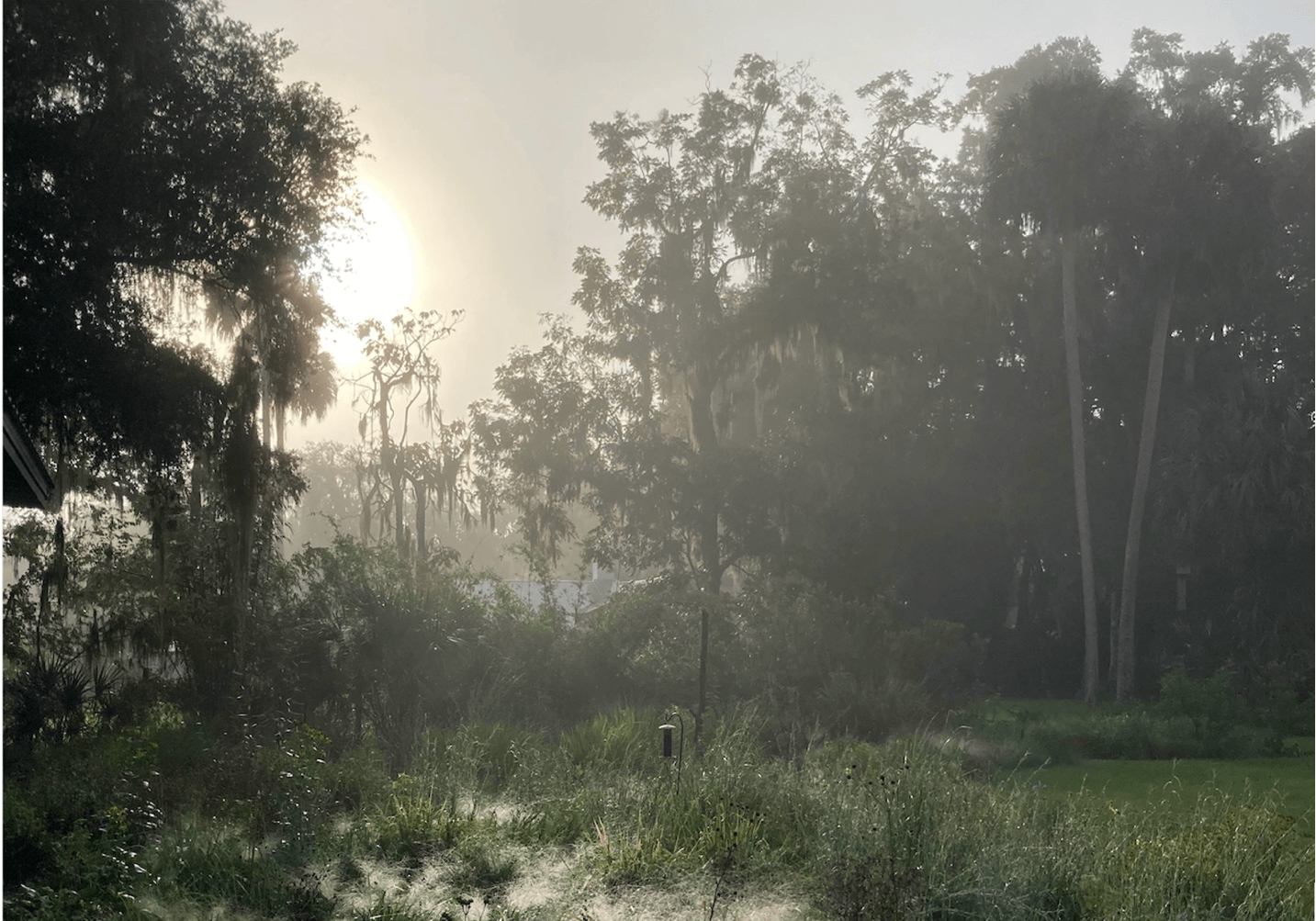
Summer morning, native-plant garden, Micanopy Florida, Summer 2022. Photo: The author.
The botanical wonders of Florida
A native-plant garden in North-Central Florida is a delight in any season. In the Spring, tender shoots of wiregrass, bluestem and dropseed emerge from the ground, providing a cool backdrop for sprays of hot yellow tickseed flowers. Purple-blue spiderwort comes into blossom every morning and closes every night. In the summer, it’s time for zesty blanket flowers with their gaudy yellow and orange heads. Partridge pea attract hundreds of bees and moths, and milkweed is home to the iconic monarch butterfly — as honored and beloved an American resident as the bald eagle.
In the Autumn, blazing star sends purple clusters heavenward while the last of the firebush blossoms nourish Hummingbirds for their long migration south. You know winter
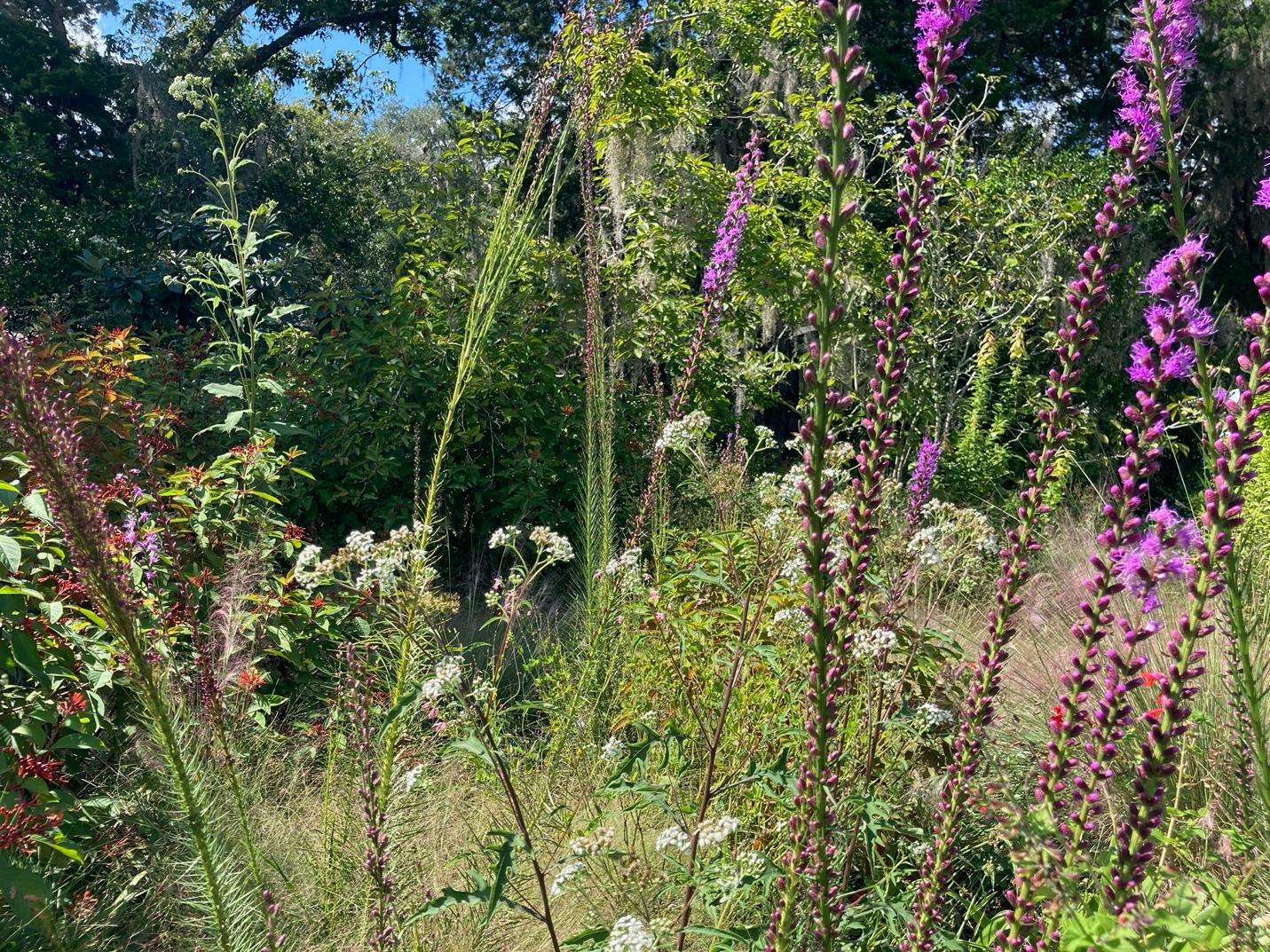
Blazing-star, firebush, and purple top-grass, early Autumn, Micanopy, Florida, 2022. Photo: Harriet Festing.
has arrived not so much by the temperature change – though it can be downright chilly at night – as by the disappearance of color. The flowers are gone, and the grasses dormant. The dull brown allows our eyes to rest and recover before the colorful reawakening of spring.
These are among the many, visual pleasures of the Florida, native-plant garden. Add to that the birds it beckons – sandhill cranes, cardinals, bluebirds, tufted titmice, red-wing blackbirds, gnatcatchers, wrens, warblers, and pileated woodpeckers – and you have a symphony of sound as well as color. And lastly, we mustn’t forget the many animals that make the Florida landscape home, including spadefoot frogs, green anoles, black racer snakes, gopher tortoises, moles, voles, armadillos, and deer; if you are lucky, an occasional black bear will amble through! All are embraced by the Florida gardener who plants and designs as much for her non-human visitors as for herself, her family, and her friends.
Gardens under threat!
But even in gardens as welcoming as these, some species must be KEPT OUT. I’m not talking about Burmese pythons and Brazilian pepper trees. The first, now endemic in the Everglades, consumes endangered birds, mammals, amphibians, and reptiles, while the other crowds out native trees and plants. They are bad, but worse is the creature that threatens nature and civilization itself. I’m talking, of course about the Florida fascist. The newest and most destructive are the MAGA varieties: White Lives Matter, Sunshine State Nationalists, NatSoc Florida, Florida Nationalists and many others. They join the already endemic and better studied Proud Boys (superbus purorum) and Oath Keepers (jusjurandum custodes). Their numbers increase every election season.
If any of these fascists enter your garden, they can wreak havoc, turning even the most pacific gardener into a potential exterminator. But there are natural ways to protect our gardens and ourselves from this most unwelcome of guests. All they require is mastery of a few basic tools and materials. With a little effort, your house and garden can be kept fascist free!
Top five tips to achieve a fascist free garden!
No. 5: Build a wall
Walls and fences are an effective deterrent to fascists. But the best ones are beyond the budget of most gardeners. They require dressed stone or steel bars, bullet-proof security cameras with 24/7 monitoring, and an armed, rapid response force. A more affordable solution is a simple, cinder block wall topped with broken glass or razor wire. With the help of YouTube instructional videos, and a supply of broken beer bottles, almost anyone can build a wall themselves. By posting on social media – especially Parler or Rumble — that you are planning to “Build the Wall,” you might even enlist the help of local MAGA fascists!
No. 4 Cognitively dissonant yard signs
Everybody knows that signs, slogans, flags, banners, and baseball caps cast a heliotropic spell upon fascists. They incline toward American, Confederate and Blue Live Matter Flags; are hypnotized by NRA and U.S. Marine Corps logos; and adore MAGA and QAnon caps and banners. The anti-fascist gardener is thus advised to post a mix of these – on flag poles, wooden posts, and car windows or bumpers – alongside signs or logos for Planned Parenthood, the ACLU, and Black Lives Matter. An LGBTQ rainbow flag makes a stunning counterpoint to the Florida flag with its white field, red saltire cross and state seal in the middle. The resulting cognitive dissonance will have the effect of freezing most fascists in their tracks — it will cause them to think. That offers gardeners the opportunity to gently usher fascists off the premises.
No. 3. Invertebrate protection
Nearly all Florida native gardens possess a largely unseen army of potential anti-fascists: Mosquitos, wasps, chiggers, ticks, and biting ants. Gardeners who want to protect their
homes and property are therefore well advised to encourage insect proliferation. Leave old tires in selective places to collect water – the result is an attractive water feature that also provides a place for mosquitos to breed. Never disturb wasp nests under eaves, or on the underside of palm fronds; they are architecturally distinctive, and their residents deliver a nasty sting. Leave lawn grass tall to provide perches for ticks and chiggers to launch themselves onto unwary legs. All these are surefire strategies to deploy local invertebrates to repel spineless fascists.
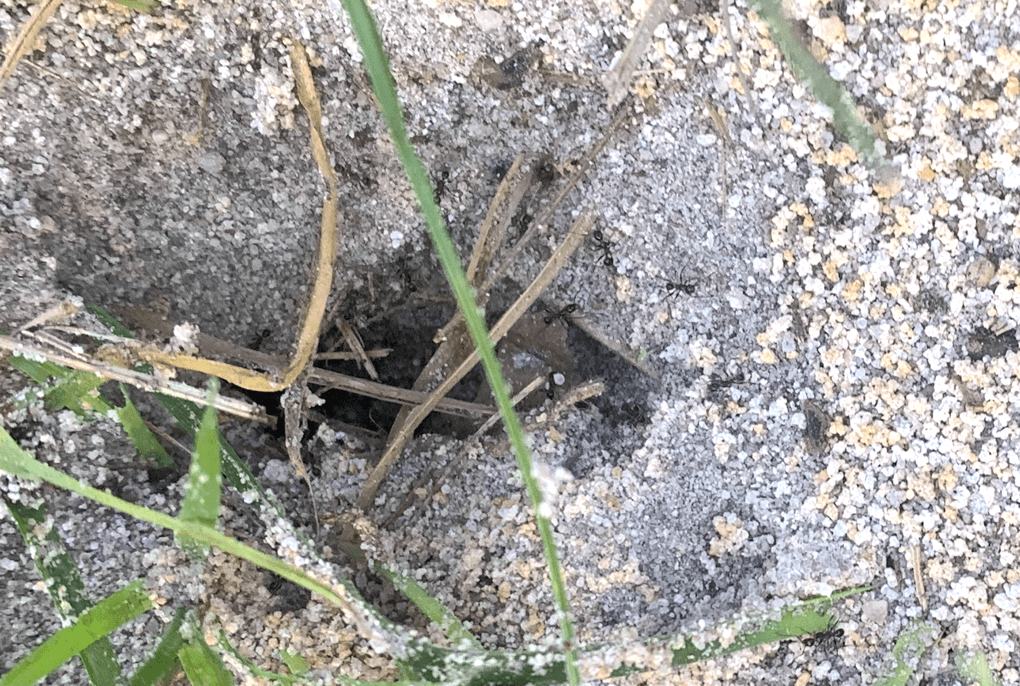
Ant colony, Micanopy, Florida, October 2022. Photo: The author.
No. 2. Defensive planting
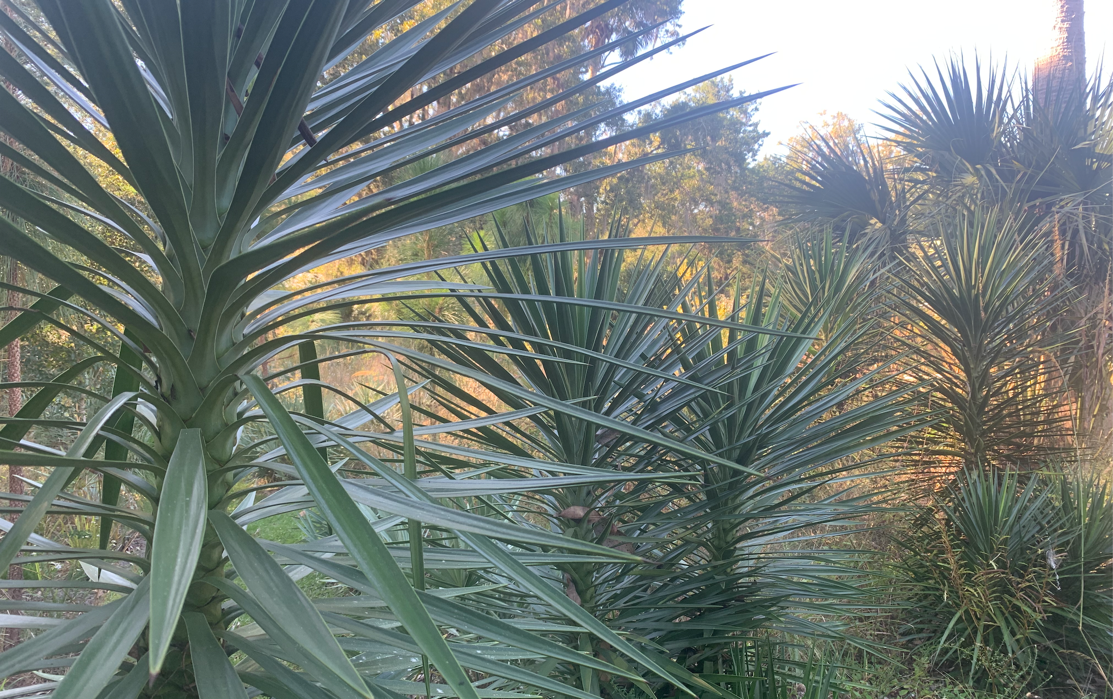
Spanish bayonet, Micanopy, Florida, October 2022. Photo: The author.
Many plants are both attractive and protective. The leaves of Spanish bayonet are as sharp as daggers; planted close together, they are an impregnable barrier. Saw
palmettos grow wide, tall, and dense, and their leaves are serrated – they are also ideal habitat for the eastern diamondback rattlesnake, whose bite is potentially fatal. Dog hobble creates a dense thicket of branches close to the ground, tripping up anybody who tries to cross them. Water oaks grow large and spreading and their heavy branches have a tendency to fall without warning, clobbering on the head anybody below. Blackberry brambles spread aggressively and are covered with sharp spines; plus, their delicious berries are a distraction for any invading fascist!
No. 1. Florida’s apex predator
Nobody isn’t afraid of alligators. The textbooks say alligators are less aggressive than crocodiles, but any resident of Florida knows that’s untrue. On land or in the water, they yield to nobody but instead confront the unwary visitor with flashing eye and a low growl that sounds like “Vuk -uuuu”. That’s about as much warning as you will get
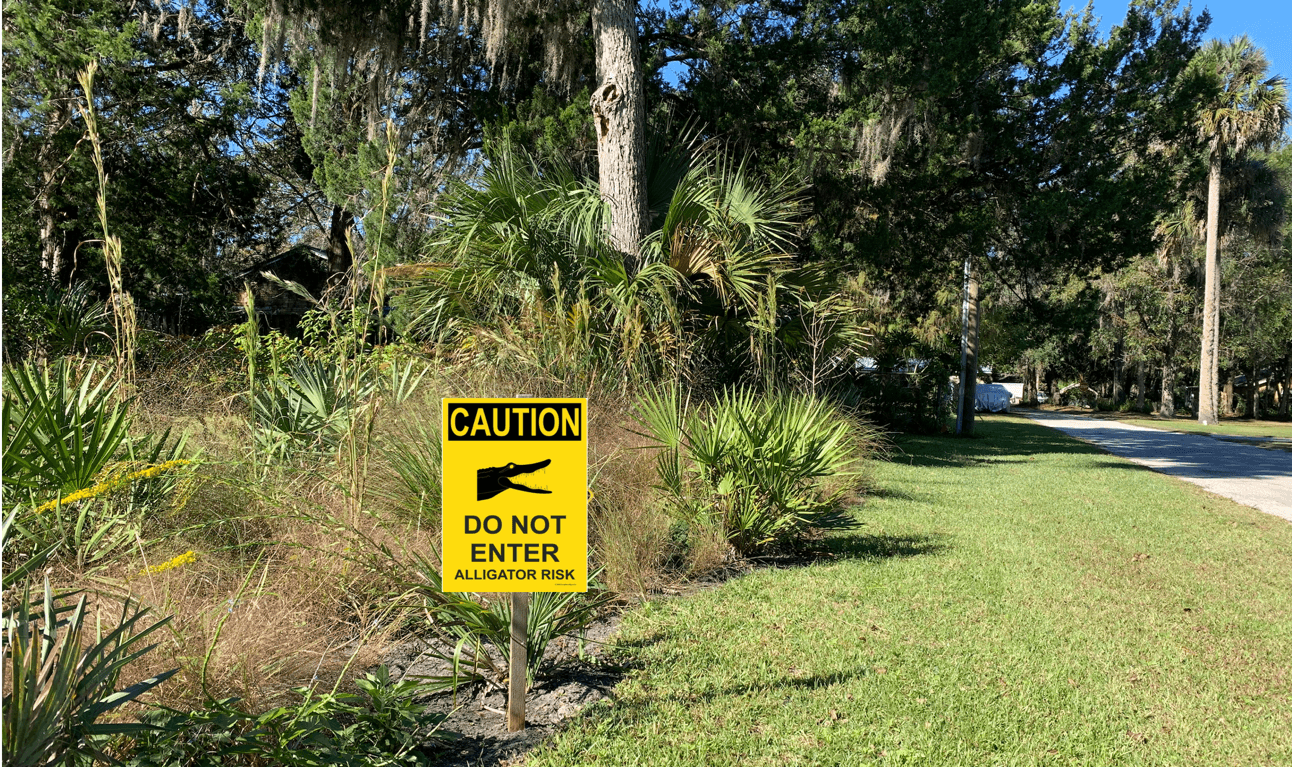
Border of Florida native garden, Micanopy, Florida, October 22. Photo: The author.
before an attack. If someone – a fascist for example — accidentally approaches an alligator, it will lunge and clamp hold of an arm or leg, ripping off great chunks of flesh or else pulling the victim into the water to execute a death-roll. The poor drowned, schmuck can then be consumed by the animal at leisure. Digging even a small pond on your property – ours is about 20 x 30 feet — may be sufficient to attract a resident alligator, or even two! A single “Alligator Risk” sign may be all you need to keep your Florida garden fascist free for many election cycles to come!